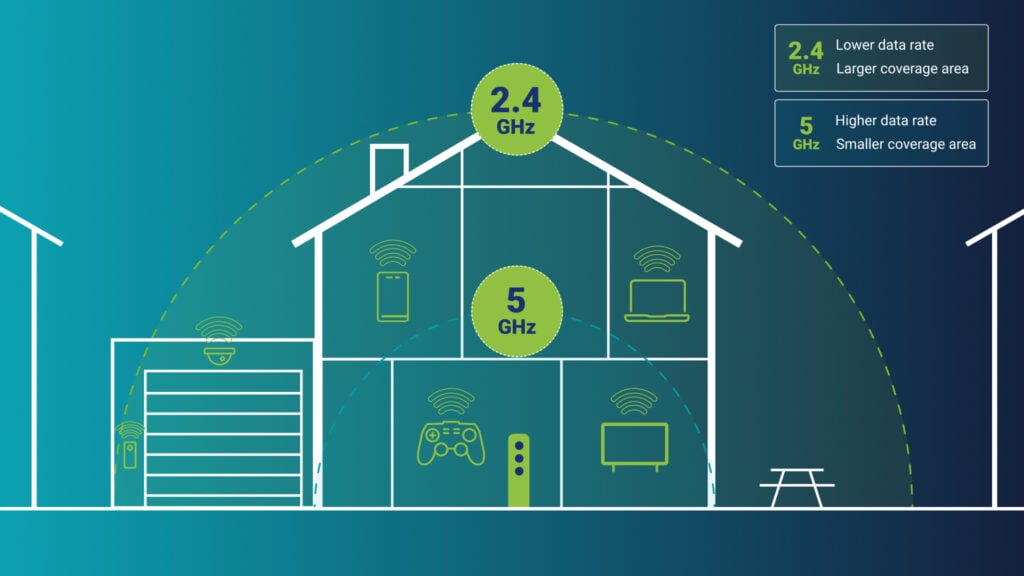
Insights
2.4GHz vs 5GHz: What’s the difference?
Are you thinking of getting a new router or thinking about your current internet speed, but feeling overwhelmed by all the technical terms like 2.4GHz and 5GHz? Don’t worry, we are going to break it down and run through what a GHz is, the difference between 2.4GHz and 5GHz, and which one is the best option for you.
What is a GHz?
GHz stands for gigahertz, which is a unit of measurement for frequency. In the context of Wi-Fi, it refers to the frequency at which wireless signals operate, essentially serving as the ‘highway’ for data transmission between devices.
The two most common Wi-Fi frequency bands are 2.4GHz and 5GHz. The 2.4GHz band came into public use in 1999, making it the older of the two. Over time the 5GHz band was introduced to provide faster speeds and less interference.
Differences between 2.4Ghz and 5Ghz
Both the 2.4GHz and 5GHz frequency bands have advantages and disadvantages, so it’s important to consider which one is best suited for your needs.

Which frequency should you choose?
When choosing which frequency to use, consider the location of your devices in relation to the router. For devices closer to the router, such as those in the same room or nearby, opt for the 5GHz frequency. It provides a strong connection and fast speeds, ideal for activities like streaming or gaming.
However, for devices located further from the router, like those upstairs or in distant parts of the house, the 2.4GHz frequency is better. It offers wider coverage, ensuring a reliable connection even at a distance, though it may be slower. So, for daily high-speed tasks, prioritise 5GHz, while for wider coverage, especially in distant areas, 2.4GHz is the way to go.

Gaming console
Gaming consoles can use both 2.4GHz and 5GHz Wi-Fi. For smoother gaming, especially online, 5GHz is best because it processes data faster, reducing lag. However, the absolute best connection is a wired Ethernet cable directly to the router, if possible. But for those with consoles further away or not needing top speed, 2.4GHz may be used. For more gaming broadband tips, check out our Gamer’s Guide to Broadband.
Computer
For computers, a 5GHz connection is best, especially for video calls or streaming. If you’re unsure about streaming speeds, check out our article here. But for laptops, a 2.4GHz connection might be better. Laptops move around, and 2.4GHz provides wider coverage for stability.
Smart TV
For devices like 4K smart TVs that thrive on fast Wi-Fi, connecting to the 5GHz option ensures a seamless experience for the whole family. However, for streaming devices placed further from the router, opting for the 2.4 GHz connection may offer a more reliable signal.
Smartphone
For mobile phones and tablets moving around the house, a 2.4GHz connection is better because it has a wider range. This ensures stable connectivity as devices shift between rooms, providing uninterrupted usage throughout your home.
Why can’t I connect to 5GHz?
There can be a few reasons that your device can only see the 2.4GHz, the most common is that it isn’t compatible with the 5GHz frequency. Some devices, like doorbells, cameras, and smart speakers, are set to only use the 2.4GHz frequency. The 2.4GHz band has been around longer and offers a better range, so older devices and those designed for wider coverage typically operate on this frequency.
If you’re having trouble reaching devices with the 5GHz connection, there are ways to boost its range. One option is to upgrade to a newer router with better range capabilities. Another option is to implement Wi-Fi boosters into your network, which can extend the coverage of your existing router. Additionally, you can run a cable from the main router to a second router or booster strategically placed in your home to amplify the signal to areas where it’s needed most. These methods can help ensure a reliable 5GHz connection throughout your home, even for devices located further away from the router.
How do I know if my Wi-Fi is 2.4GHz or 5GHz?
An easy way to check your internet speed is to use our online speed test software click here. For the best results, connect your PC or laptop directly to the router with an ethernet cable. Once connected, run the speed test. Slower speeds over a wider area usually mean you’re on 2.4GHz, while faster speeds with a shorter range likely indicate 5GHz. To switch between the two frequencies, just log onto your router’s settings using a web browser. Then, pick the frequency band you like in the wireless settings section. If your router doesn’t let you choose, then check the user manual for guidance.
The future of Wi-Fi: What is 6GHz?
In recent years, Wi-Fi has expanded with the addition of the 6GHz frequency. While not as common as 2.4GHz and 5GHz, devices with Wi-Fi 6E can fully utilise it for better connectivity.
Pros:
- Can transmit more data over the same distance, leading to faster speeds.
- Enables smoother streaming, quicker downloads, and improved performance for compatible devices.
Cons:
- Shorter range compared to other frequencies, potentially requiring more access points for full coverage.
- Only accessible to devices equipped with Wi-Fi 6E capability.
How we can help
Let’s make your broadband setup hassle-free with our expert help. Our skilled engineers will handle everything, and we offer flexible contract options to suit you. Ready to upgrade your broadband? Get in touch with us here for more info!
Latest news
A network for the future
Why Jurassic Fibre?


